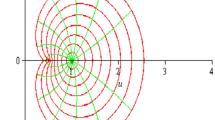Abstract
In three papers, Meinardus (Über das Syracuse-Problem, Preprint Nr. 67, Universität Mannheim, 1987) and Berg and Meinardus (Results Math 25:1–12, 1994; Rostock Math Kolloq 48:11–18, 1995) have shown that the Collatz \(3n+1\) problem for positive integers \(n\) as start values can be put into the theory of complex analysis. Here we investigate the Collatz \(3n+1\) problem for negative start values. This problem is equivalent to the \(3n-1\) problem for positive start values. It is known, that this problem differs from the \(3n+1\) problem. One aspect is, that all positive start values tend, at least empirically, to either 1, 5 or 17. We describe the corresponding analytic problem for this case, where one has to show that there are not more than three linearly independent, holomorphic solutions for this problem. We conjecture that these solutions have the unit circle as natural boundary. However, the \(3n-1\) problem remains open.


Similar content being viewed by others
References
Ahlfors, L.V.: Complex Analysis. McGraw-Hill, New York (1953)
Berg, L., Meinardus, G.: Functional equations connected with the Collatz problem. Results Math. 25, 1–12 (1994)
Berg, L., Meinardus, G.: The \(3n+1\) Collatz problem and functional equations. Rostock. Math. Kolloq. 48, 11–18 (1995)
Berg, L., Opfer, G.: An analytic approach to the Collatz \(3n+1\) problem for negative start values with an appendix of tables. Hamburger Beiträge zur Angewandten Mathematik (2012). http://preprint.math.uni-hamburg.de/public/papers/hbam/hbam2012-11.pdf
Böhm, C., Sontacchi, G.: On the existence of cycles of given length in integer sequences like \(x_{n+1}=x_n/2\) if \(x_n\) even, and \(x_{n+1}=3x_{n}+1\) otherwise. Atti Accad. Naz. Lincei Cl. Sci. Fis. Mat. Natur. Rend. Lincei (8) Mat. Appl. Vol. LXIV (1978), pp. 260–264
Collatz, L.: Über die Entstehung des (3n+1) Problems. J. Qufu Norm. Univ. Nat. Sci. Ed., 3, 9–11 (1986) (in Chinese). (The German title as used here was handwritten by Collatz on a copy of the Chinese paper.)
Crandall, R.E.: On the “\(3x+1\)” problem. Math. Comp. 32, 1281–1292 (1978)
Erdős, P.: Note on the converse of Fabry’s gap theorem. Trans. AMS 57, 102–104 (1945)
Fabry, E.: Sur les points singuliers d’une fonction donnée par son développement en série et l’impossibilité du prolongement analytique dans des cas très généraux. Ann. Sci. Ecole Norm. Sup. 13(sér 3), 367–399 (1896)
Guy, R.K.: Don’t try to solve these problems. Am. Math. Monthly 90, 35–41 (1983)
Lagarias, J.C. (ed.): The Ultimate Challenge: The \(3x+1\) Problem. Amer. Math. Soc, Providence (2010)
Meinardus, G.: Über das Syracuse-Problem, Preprint Nr. 67, Universität Mannheim (1987)
Opfer, G.: An analytic approach to the Collatz \(3n+1\) problem. Hamburger Beiträge zur Angewandten Mathematik, Preprint Nr. 2011–09 (2011). http://preprint.math.uni-hamburg.de/public/papers/hbam/hbam2011-09.pdf
Pólya, G.: On converse gap theorems. Trans. AMS 52, 65–71 (1942)
Wirsching, G.J.: The dynamical system generated by the \(3n+1\) function, Lecture Notes in Mathematics, vol. 1681, p. 159. Springer, Berlin (1998)
Wirsching, G.J.: Über das \(3n+1\) Problem. Elem. Math. 55, 142–155 (2000)
Acknowledgments
The research of the second mentioned author was supported by the German Science Foundation, DFG, GZ: OP 33/19-1. The same author would like to thank the librarian, Ruth Ellebracht, of the Department of Mathematics of the University of Hamburg for her permanent help in searching for the relevant literature. We thank an unknown reviewer for his (her) valuable and very detailed comments.
Author information
Authors and Affiliations
Corresponding author
Additional information
Communicated by Dmitry Khavinson.
Rights and permissions
About this article
Cite this article
Berg, L., Opfer, G. An Analytic Approach to the Collatz \(3n+1\) Problem for Negative Start Values. Comput. Methods Funct. Theory 13, 225–236 (2013). https://doi.org/10.1007/s40315-013-0017-z
Received:
Revised:
Accepted:
Published:
Issue Date:
DOI: https://doi.org/10.1007/s40315-013-0017-z
Keywords
- Collatz \(3n+1\) problem for negative start values
- \(3n-1\) problem
- Linear operators acting on holomorphic functions
- Natural boundary



